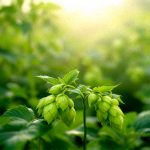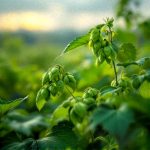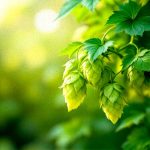Takeaways
- Hops are flowering plants used primarily in beer brewing
- They contain compounds that provide bitterness and aroma to beer
- Hops have potential health benefits, including aiding sleep and relaxation
- Various forms of hops are available for consumption beyond brewing
- Sustainable farming practices are becoming more common in hop cultivation
- New hop varieties and applications are emerging beyond the brewing industry
Introduction to Hops
Hops, scientifically known as Humulus lupulus, are flowering plants belonging to the Cannabaceae family.[1] These plants grow cone-shaped flowers, called hops, that are widely used by brewers to make beer.[2] Hops contribute bitterness, distinct flavors, and aromas that balance the sweetness of malt in beer.[3]
Beyond their use in brewing, hops are gaining attention for their potential health benefits.[4] Some people use hops to help with sleep and to reduce anxiety.[5] The increasing interest in both craft beer and natural health remedies has made hops more popular recently.
Hops are available in different forms, each suited for particular purposes.[6] Brewers commonly use whole hop cones, compressed hop pellets, and concentrated hop extracts.[7] For health uses, you can find hop supplements, teas, and essential oils.[8] Some cooks even experiment with hops as a unique food ingredient.
Historical Background
Origins and Early Use
The exact origin of hops is not completely clear, but historians think they first grew naturally in China and Europe.[9] Ancient civilizations used hops for medicine long before they were used in beer.[10] The first documented case of hops being used in beer is from 8th century Germany.[11]
The cultivation of hops started in monasteries and small farms.[12] Monks found that hops helped preserve beer, making it last longer.[13] This discovery led to more hop farming and trade across Europe. By the 15th century, the use of hops in brewing had spread to England and other European areas.[14]
Evolution in Brewing
Hops significantly changed the brewing industry by improving both the flavor and preservation of beer.[15] Before hops, brewers used a mix of herbs called “gruit” to flavor beer.[16] Hops offered a more consistent and enjoyable taste, quickly becoming the preferred flavoring ingredient.
In 1516, the German Purity Law, also known as Reinheitsgebot, stated that beer could only contain water, barley, and hops.[17] This law solidified the importance of hops in brewing history. Other countries soon followed with similar rules, establishing hops as a necessary ingredient for beer globally.
Botanical Characteristics
The hop plant is a climbing vine that grows back each year and can reach up to 20 feet in height.[18] It has large leaves with lobes and produces small, green flowers called cones or strobiles.[19] These cones contain the valuable components that brewers and others seek.
Main varieties of hops include:
- Cascade: Known for its citrusy aroma
- Saaz: Prized for its spicy, earthy notes
- Hallertau: Offers a mild, slightly spicy flavor
- Centennial: Provides a balanced bitterness and floral aroma
Hop cones are made of layers of bracteoles and bracts, creating a paper-like structure.[20] At the base of these bracteoles are lupulin glands.[21] These glands produce the resins and essential oils that give hops their unique properties.[22]
Cultivation and Harvesting
Hops grow best in moderate climates with long summer days.[23] They need soil that drains well, lots of sunlight, and strong support structures to climb.[24] Farmers often grow hops on trellises or wire systems that can reach 18 to 20 feet in height.[25]
The hop harvest typically occurs in late summer or early fall.[26] Farmers decide when to harvest by checking the color, texture, and lupulin content of the cones. Harvesting involves cutting down the hop vines and separating the cones from the leaves and stems.[27]
| Region | Typical Varieties | Climate Characteristics |
|---|---|---|
| Pacific Northwest (USA) | Cascade, Centennial | Cool summers, mild winters |
| Bavaria (Germany) | Hallertau, Tettnang | Continental climate, warm summers |
| Kent (England) | East Kent Goldings, Fuggle | Temperate maritime climate |
| Bohemia (Czech Republic) | Saaz | Continental climate, cold winters |
Chemical Composition
Hops contain a complex mix of chemical compounds that give them their distinct characteristics.[28] The most important of these are alpha and beta acids, essential oils, and polyphenols.[29]
| Compound Type | Examples | Primary Effects |
|---|---|---|
| Alpha Acids | Humulone, Cohumulone | Bitterness in beer, antimicrobial properties |
| Beta Acids | Lupulone, Colupulone | Aroma, preservative effects |
| Essential Oils | Myrcene, Humulene | Flavor and aroma in beer, potential health benefits |
| Polyphenols | Xanthohumol, Quercetin | Antioxidant properties, potential health benefits |
These compounds work together to create the characteristic taste and aroma of hops. They also contribute to the potential health benefits that are associated with consuming hops.
Alpha and Beta Acids
Alpha acids are the main source of bitterness in beer.[30] During brewing, heat causes these acids to change into bitter-tasting compounds.[31] The amount of alpha acids in hops determines how bitter the beer will be.
Beta acids contribute less to the bitterness but do affect the aroma and flavor of beer.[32] They also have preservative qualities, which help beer last longer. Both alpha and beta acids have antimicrobial effects, which helped establish hops as a valuable ingredient for brewing.
Essential Oils
The essential oils in hops are largely responsible for the plant’s aroma.[33] These compounds evaporate easily, which is why brewers often add aroma hops late in the brewing process or use a technique called dry hopping.[34]
The composition of essential oils differs among hop varieties, leading to diverse flavor profiles. For example, myrcene often produces citrus or pine notes, while humulene creates earthy, woody aromas.[35] These oils not only impact the flavor of beer but also may offer some health benefits.
Hops in Brewing
Hops serve multiple purposes in beer brewing. They balance the sweetness of malt, add bitterness and flavor, contribute to aroma, and help preserve the beer.[36] Brewers carefully choose hop varieties and decide when to add them during the brewing process to achieve the results they desire.
Steps where brewers add hops:
- Bittering: Early in the boil for maximum bitterness extraction
- Flavor: Midway through the boil for a balance of flavor and bitterness
- Aroma: Near the end of the boil or after to preserve volatile compounds
- Dry hopping: Added to the fermenter for intense aroma without bitterness
Dry hopping involves adding hops to beer after the initial fermentation. This method creates strong hop aromas without increasing bitterness.[37] It is popular in many craft beer styles, particularly India Pale Ales (IPAs).
Bittering vs. Aroma Hops
Brewers often categorize hops as either bittering or aroma hops, although many varieties can serve both purposes.[38] Bittering hops typically have higher alpha acid content and are added early in the boiling process.[39] Aroma hops, with their complex oil profiles, are usually added later to preserve their volatile compounds.[40]
Balancing bittering and aroma hops is a key skill in brewing. Too much bitterness can overpower a beer, while too little can make it taste bland or too sweet. The right balance creates a harmonious flavor that defines different beer styles.
Impact on Beer Styles
Different hop varieties and usage methods contribute to the unique character of different beer styles. For example, German lagers often use noble hops like Hallertau, which provide a subtle, spicy aroma. American pale ales and IPAs often showcase citrusy, piney hops like Cascade or Simcoe.
Popular beer styles and their characteristic hop profiles:
- India Pale Ale (IPA): Bold, citrusy American hops
- Pilsner: Delicate, spicy noble hops
- English Bitter: Earthy, floral British hops
- American Wheat: Light, citrusy hop character
Brewers continue to experiment with new hop varieties and combinations, leading to innovative beer styles and flavors.
Health Benefits and Uses
Beyond brewing, hops have attracted attention for their potential health benefits. Traditional medicine has used hops for centuries, and current research is exploring these historical claims. Although more studies are needed, initial findings suggest several promising areas.
Hops contain compounds that may offer health advantages. These include prenylated flavonoids, which have antioxidant properties, and bitter acids that may influence metabolism. However, it’s important to note that most research is in its early stages and often uses concentrated hop extracts.
Sleep and Relaxation
One of the most well-known potential benefits of hops is their ability to promote sleep and relaxation. Hops have been used as a mild sedative in traditional medicine for many years. Current studies are beginning to explore the scientific reasons behind these effects.
Research indicates that certain compounds in hops may interact with GABA receptors in the brain, which helps promote relaxation. A study in PLOS One found that a combination of hops and valerian root improved sleep quality in people with insomnia. Although these results are encouraging, further research is needed to fully understand how hops affect sleep.
Antioxidant Properties
Hops contain several compounds with antioxidant properties. Antioxidants help protect cells from damage caused by free radicals, which can contribute to various chronic diseases. Xanthohumol, a flavonoid in hops, has shown strong antioxidant activity in lab studies.
These antioxidant properties might have implications for overall health. Some researchers are investigating if hop compounds could help prevent conditions related to oxidative stress. However, most studies have been done in test tubes or animals, and human trials are still limited.
Other Potential Benefits
Scientists are exploring several other possible health applications for hops. While research is still in progress, some areas of interest include:
- Metabolic health: Some studies suggest hop compounds might influence fat metabolism
- Menopausal symptoms: Hop extracts may help alleviate some symptoms of menopause
- Dental health: Certain hop compounds show antimicrobial properties against oral bacteria
- Cardiovascular health: Preliminary research indicates possible benefits for heart health
It’s important to remember that much of this research is in its initial phase. More studies, especially involving humans, are needed to confirm these potential benefits and determine appropriate dosages.
Forms and Consumption
Hops are available in various forms for different uses. While most people encounter hops indirectly through beer, other products allow for direct consumption of hop compounds. The form you choose will depend on how you intend to use it and your personal preferences.
Supplements
Dietary supplements based on hops have become more popular recently. These often come as capsules or tablets containing hop extracts. People usually use these supplements for their potential to aid sleep or relaxation.
When considering hop supplements, it’s important to follow the recommended dosages. Start with a low dose and increase it gradually if necessary. Be aware that hop supplements can interact with certain medications, particularly sedatives or hormone treatments. Always consult a healthcare provider before starting any new supplement routine.
Culinary Uses
Although less common, hops have been used in some cooking applications. Their bitter and aromatic qualities can add interesting flavors to dishes. Some culinary uses for hops include:
- Hop-infused oils or vinegars
- Hop tea or other beverages
- Hop-seasoned meats or vegetables
- Hop-flavored baked goods
When cooking with hops, remember that a small amount goes a long way. Their strong flavor can easily overpower a dish if used too much. Experimentation and careful measuring are crucial for successfully adding hops to recipes.
Aromatherapy and Topical Applications
Hop essential oils are sometimes used in aromatherapy because of their calming properties. You can find these oils in diffusers, massage oils, or pillow sprays. Some skincare products also contain hop extracts, claiming potential benefits for skin health.
When using hops topically, always dilute essential oils properly and do a patch test first. Some people may experience skin irritation or allergic reactions to hop compounds. If you notice any negative effects, stop using the product and consult a healthcare provider.
Side Effects and Precautions
While hops are generally considered safe when consumed in amounts typically found in foods and beverages, they can cause side effects in some people. It’s important to be aware of potential risks, especially when using concentrated hop products or supplements.
Common side effects of consuming hops may include:
- Drowsiness or sedation
- Mild digestive upset
- Headaches
- Dizziness
These effects are typically mild and temporary. However, if you experience persistent or severe symptoms, discontinue use of hop products and consult a healthcare provider.
Hops can interact with certain medications, particularly those that cause drowsiness or affect hormone levels. If you’re taking any medications, especially sedatives, antidepressants, or hormone therapies, consult your doctor before using hop supplements.
Who Should Avoid Hops
Some people should be cautious about consuming hops or avoid them altogether. This includes:
- Pregnant or breastfeeding women
- People with estrogen-sensitive conditions
- Those with depression or taking antidepressants
- Individuals with alcohol use disorders
- People scheduled for surgery (due to potential sedative effects)
If you belong to any of these categories, consult a healthcare provider before using hop products. They can help you weigh the potential risks and benefits based on your specific health situation.
Sustainability and Environmental Impact
As hop cultivation has expanded to meet rising demand, sustainability has become an important factor in the industry. Farmers and brewers are increasingly adopting practices to reduce environmental impact and ensure the long-term viability of hop production.
Sustainable hop farming practices often focus on reducing the use of chemicals, conserving water, and promoting biodiversity. Some farmers are using organic growing methods, avoiding synthetic pesticides and fertilizers. Others are implementing integrated pest management strategies to minimize chemical use while effectively managing pests and diseases.
Water Usage
Hop plants need significant amounts of water, especially during the growing season. In many hop-growing areas, irrigation is required to supplement natural rainfall. This high water demand has raised concerns about sustainability, particularly in regions facing water shortages.
To address these concerns, many hop farmers are adopting water conservation methods:
- Drip irrigation systems for more efficient water delivery
- Soil moisture monitoring to optimize watering schedules
- Cover cropping to improve soil water retention
- Selection of drought-resistant hop varieties
These practices not only conserve water but can also lead to healthier plants and better yields. As climate change affects water availability in many regions, such conservation efforts will become more important.
Pest Management
Hop plants are susceptible to various pests and diseases, which can greatly impact crop yields and quality. Traditional pest management often relied heavily on chemical pesticides. However, growing awareness of environmental and health concerns has led to changes in pest control strategies.
Integrated Pest Management (IPM) has become a popular approach in hop farming. IPM combines various pest control methods to minimize environmental impact while effectively managing pests. Some techniques used in hop IPM include:
- Biological controls, such as introducing beneficial insects
- Cultural practices like proper plant spacing and pruning
- Use of pest-resistant hop varieties
- Targeted application of pesticides only when necessary
These approaches help maintain ecological balance in hop fields while protecting crops. They also contribute to the overall sustainability of hop production.
Future of Hops
The hop industry continues to change, driven by shifts in beer trends, advances in agricultural technology, and growing interest in the potential of hops beyond brewing. These developments are shaping the future of hop cultivation and use.
One significant trend is the development of new hop varieties. Breeders are creating hops with unique flavor profiles to meet the demand for new beer styles. Some new varieties aim to combine desirable traits like disease resistance with sought-after aroma characteristics.
Climate change is another factor impacting the future of hops. As traditional growing regions face changing weather patterns, farmers are adapting their growing methods and exploring new areas for hop production. This could lead to shifts in the global distribution of hop farming.
Beyond Brewing
While brewing remains the primary use for hops, interest in alternative applications is increasing. Researchers and entrepreneurs are exploring new ways to use hop compounds in various industries.
Some innovative products and research areas involving hops include:
- Hop-based natural preservatives for food and cosmetics
- Hop extracts in pharmaceuticals for potential therapeutic uses
- Hop-derived compounds in sustainable pest control products
- Hop fibers as a sustainable material in textiles or packaging
These emerging applications could open new markets for hop growers and processors, diversifying the industry beyond its traditional focus on brewing.
As research continues and new uses emerge, hops may play an increasingly diverse role in many aspects of our lives. From the beer we drink to potential new medicines and materials, these adaptable plants continue to show us their possibilities.
FAQ
In conclusion, hops have been important in brewing for centuries and continue to shape the beer industry today. Their unique characteristics make them crucial for creating the diverse range of beer styles we enjoy. Beyond brewing, hops offer potential benefits in health and sustainability, though further research is needed to understand these applications fully. Looking ahead, hops will likely continue to evolve and find new uses. From developing new hop varieties to exploring alternative applications, the world of hops remains dynamic and full of possibilities. Whether you’re a beer lover, a health-conscious person, or just curious about these adaptable plants, there’s always something new to discover about hops. Remember, while hops offer many potential benefits, it’s important to use them responsibly. Always consult with a healthcare provider before starting any new supplement routine, especially if you have existing health issues or are taking medications. And of course, if you enjoy hops in beer, drink in moderation and never drink and drive. As research continues and new applications emerge, our understanding and appreciation of hops will surely grow. Whether in your favorite beer, a relaxing cup of hop tea, or a future innovative product, hops are likely to remain a fascinating and valuable plant for years to come.What are the main uses of hops?
Can hops help with sleep?
Are there any side effects of consuming hops?
How do hops affect beer flavor?
What’s the difference between bittering and aroma hops?
Can you eat hops?
How are hops harvested?
What gives hops their bitter taste?
Are hops related to cannabis?
Can hops be used in cooking?
This is the correct scientific classification of hops.
The cone-shaped flower of the hop plant is indeed the part used in brewing.
Hops are crucial for balancing the sweetness of malt, while also adding flavor and aroma characteristics to beer.
Research on potential health benefits of hops is emerging.
Traditional medicine has employed hops for sedative effects, and current studies are exploring these historical claims. Many studies on this topic use concentrated extracts so more research is needed.
Source: “An Updated Review of the Genus Humulus: A Valuable Source of Bioactive Compounds for Health and Disease Prevention” https://www.ncbi.nlm.nih.gov/pmc/articles/PMC9782902/
Hops are processed into various forms for brewing and other uses.
These are the primary forms of hops used in brewing.
These forms of hops are available for potential health benefits.
The precise origin of hops is still under research, but it’s believed they originated in the northern hemisphere.
Hops have a long history of medicinal use.
The earliest documented use is debated, but there’s general agreement that they were used in German brewing by the 8th-9th century CE.
Monasteries were important in the early development of hop cultivation.
The antimicrobial properties of hops do indeed contribute to preservation.
Hop usage did spread through Europe by this time.
Hops revolutionized brewing with their unique contribution.
‘Gruit’ was a common pre-hop herbal mixture used for flavoring beer.
The Reinheitsgebot did indeed specify these ingredients.
Hops are perennial climbing vines, called bines, that can grow to this height.
This is a correct description of the hop plant’s morphology.
This describes the structure of a hop cone.
Lupulin glands are indeed located at the base of bracteoles.
Lupulin glands are the source of these important brewing compounds.
Hops need a specific climate to grow well.
These are the key needs of hop plants.
This is the typical setup for commercial hop farms.
The specific harvest time depends on the region and the variety of hops.
This is how hop harvesting is done.
The chemical complexity of hops is key to its properties.
These are the major components that give hops their flavor, aroma, and other properties.
Alpha acids contribute the most to the bitter taste.
Isomerization of alpha acids during the boil releases the bitterness.
Beta acids are less bitter but contribute to flavor profiles.
Essential oils are the primary drivers of hop aroma.
To preserve the volatile aroma compounds, late additions or dry hopping are used.
These are common aroma characteristics attributed to these hop oils.
Source: “An Updated Review of the Genus Humulus: A Valuable Source of Bioactive Compounds for Health and Disease Prevention” https://www.ncbi.nlm.nih.gov/pmc/articles/PMC9782902/
These are the primary functions of hops in beer brewing.
Dry hopping is used to impart aroma without significantly increasing bitterness.
Hops are often categorized based on alpha acid content.
Higher alpha acid hops are typically boiled early to maximize bitterness.
Lower alpha hops added later retain more aroma.



